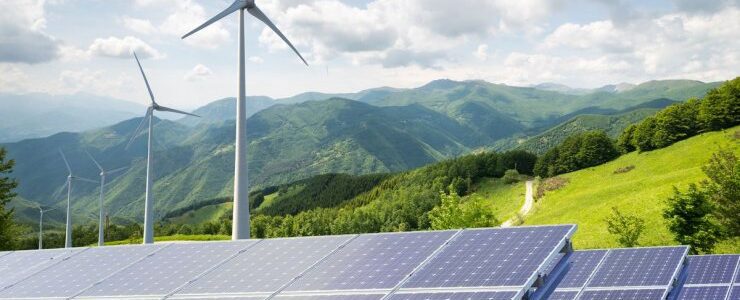
The share of energy from renewable sources in Ukraine should grow to 27% by 2030, including in the electric power industry – to 25%, heating and cooling – to 35%, transport – 14%.Achieving these goals provides for the draft National Action Plan for the Development of Renewable Energy for the period up to 2030 developed by the State Agency on Energy Efficiency and Energy Saving of Ukraine and published for discussion on its website.
According to the draft document, it was developed, in particular, taking into account the results of the implementation of the National Action Plan 2020, according to which it was supposed to achieve indicators of the use of green energy in the electric power industry of 11%, heating and cooling – 12.4%, and transport – 10%. At the same time, upon fulfillment of the plan, these figures were 13.9%, 9.3% and 2.5%, respectively.
With this in mind, the agency proposes to ensure the further development of renewable energy on a competitive and market basis, including within the framework of an auction support system, namely, according to the Feed-in-Premium model.
According to the agency, the use of corporate power purchase agreements (PPA) will increase the share of renewable energy sources in the energy balance without additional financial burden on the state and consumers.
The agency also focuses on the need to introduce a system for issuing guarantees of the origin of electricity from alternative sources, including consumers who build green power plants for their own consumption.
“In the future, the Ukrainian system for issuing guarantees of origin of electric energy should be connected to the European hub of the Association of Issuing Bodies (AIB) and the regional register of guarantees of origin of the Energy Community,” the agency said.
In addition, it proposes to give priority to the development of renewable energy in the next 10 years to the regions with underdeveloped renewable energy capacities and energy-deficient regions, mainly northern ones, since by 2021 approximately 55% of renewable energy facilities have been built in five southern regions (Dnipropetrovsk, Zaporizhia, Kherson, Mykolaiv and Odesa).
“This will be facilitated by holding auctions with certain regions,” the authors of the draft document said.
According to it, special attention in terms of the development of RES will be paid to Donetsk and Luhansk regions, the exclusion zone of the Chornobyl nuclear power plant is called a favorable territory for the development of RES.
According to the document, further government incentives for the development of solar power will be minimal, since the indicators of its development in accordance with the National Action Plan 2020 have been more than tripled.
It is planned that the capacity of solar power plants can be increased to 10 GW (currently it is 6.3 GW).
At the same time, National Action Plan 2030 provides for the intensive development of generation using wind energy, biomass and biogas, since their development is significantly behind the previous plan. As for bioenergy, one of the options is the conversion of coal and gas thermal power plants to work on alternative fuels, including biomethane.
Electricity production from wind energy in Ukraine can be increased by using more powerful wind turbines and commissioning new capacities of onshore wind farms. It is planned to increase such capacities up to 4.7 GW by 2030, offshore wind farm capacities to 300 MW (now it is 1.53 GW).
According to the plan, the bio-generation capacity should increase to 1.5 GW (currently 244 MW).
In addition, the plan provides for the development of hydroelectric power through, in particular, small hydroelectric power plants, as well as geothermal installations.
Regarding prosumers, it is noted that a potential model for their support instead of the feed-in tariff may be the use of the Net billing system, which provides for the use of netting for the supplied and consumed electricity between the supplier and the consumer in monetary units.
Another important market participant should be virtual aggregators – intermediaries between small players and the market, allowing consumers to sell their controlled loads and electricity that they generate and/or accumulate.
To ensure the technical integration of RES into the energy system, the plan provides for the commissioning of new highly flexible capacities with the ability to quickly start up in the amount of 1,350 MW and energy storage systems in the amount of 640 MW in 2030.
As for the consumption of green energy in heating and cooling systems, the plan indicates the need to create conditions for providing thermal power facilities with fuel.
“The mechanism for organizing the biofuel market in Ukraine should be the use of an electronic platform where all interested producers and consumers will trade it, as is the case in Lithuania on the Baltpool exchange,” the authors of the document said.
In addition to the available woody biomass, energy plants grown on marginal lands, as well as biomethane, are a promising renewable source for the production of thermal energy.
“It is advisable to increase the production of renewable thermal energy through the introduction of solar collectors, especially in the southern regions of Ukraine, where the amount of total solar radiation is 1,300-1,400 kWh per m2. The technically achievable potential of solar energy for heat production is, according to various estimates, 14.5-17 billion kWh per year,” the agency also said.
With regard to transport, according to the plan, the use of green energy in the transport sector is proposed at the expense of electricity produced from renewable energy sources, liquid and gaseous derivatives of biomass, and green hydrogen.
“The transformation of the industry will also be facilitated by changes to the Tax and Customs Codes of Ukraine to stimulate the development of the eco-transport industry in Ukraine, which will come into force on January 1, 2022,” the authors of the draft said.